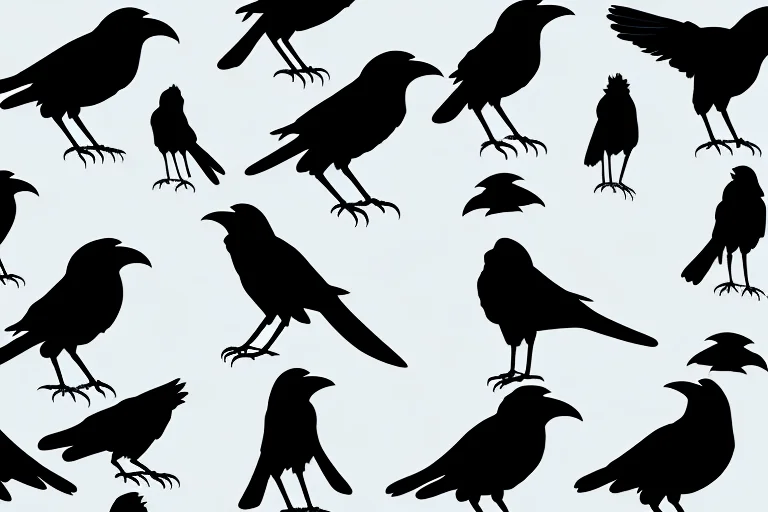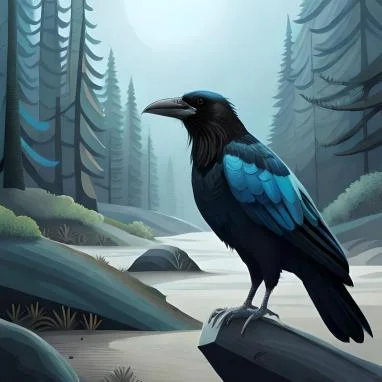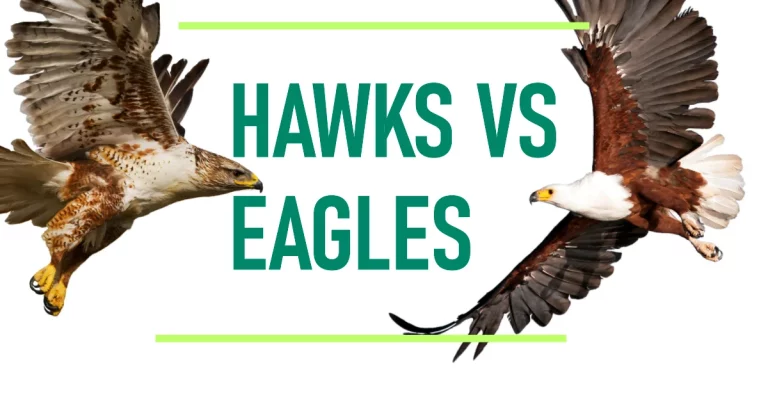Difference Between Crows and Ravens: An In-Depth Comparison

Did yo know How make difference between crows and ravens? These two birds are often mistaken for each other due to their similar appearance.
The American Crow and the Common Raven are both types of birds that belong to a group called the Corvus genus.
This group has different families and species, with two important ones called Corvidae and Corvini.
Learn about the distinctions between ravens and crows. We’ll cover their size, habitat, behavior, tail feathers, and lifespan.
Let’s dive in!
Key Differences Between Crows and Ravens
| Feature | Crow | Raven |
|---|---|---|
| Size | Smaller | Larger |
| Weight | 0.7-1.5 kg (1.5-3.3 lb) | 1-1.5 kg (2-3.3 lb) |
| Wingspan | 90-100 cm (35-39 in) | 120-150 cm (47-59 in) |
| Tail | Fan-shaped | Wedge-shaped |
| Beak | Straight and pointed | Curved and hooked |
| Call | Harsh, cawing sound | Deep, croaking sound |
| Behavior | Social, often seen in flocks | Less social, often seen alone or in pairs |
| Habitat | Varied, including urban areas, forests, and open country | More likely to be found in remote wooded areas |
| Diet | Omnivorous, eating a variety of foods including insects, small animals, fruit, and seeds | Omnivorous, eating a variety of foods including larger animals, carrion, and garbage |
Detailed Comparison of Crows and Ravens

Size
Ravens are larger than crows. A common raven is about 2-2.25 feet long and its wingspan is around 3.5-4 feet. An American crow is about 1.5 feet long and its wingspan is about 2.5 feet.

Appearance
Ravens have pointed wings and wedge-shaped tails, while crows have blunt and splayed wings with fan-shaped tail feathers . The beak of a raven is bigger and heavier than the beak of a crow.
Call/Sound
The call or sound of these birds is another distinguishing factor. The most familiar call of a raven is a deep, reverberating croak or “gronk-gronk.”
Crows make the familiar “caw-caw,” but also have a large repertoire of rattles, clicks, and bell-like notes.
Behavior
In terms of behavior, ravens often travel in pairs while crows are usually seen in larger groups. Ravens are also known to soar in the sky, unlike crows which tend to flap their wings more often.
| Feature | Crow | Raven |
|---|---|---|
| Social behavior | More social, often seen in flocks | Less social, often seen alone or in pairs |
| Communication | Harsh, cawing sound | Deep, croaking sound |
| Problem-solving skills | Highly intelligent, able to solve complex problems | Extremely intelligent, able to solve even more complex problems |
| Tool use | Capable of using simple tools | Capable of using more complex tools |
| Mimicry | Some species can mimic human speech | Some species can mimic a wider range of sounds, including human speech |
| Inequity aversion | Sensitive to inequity, may refuse to cooperate if they feel they are being treated unfairly | Highly sensitive to inequity, may even punish other individuals who they perceive as being unfair |
Habitat
Ravens prefer wilder areas and the countryside, whereas crows are more common in urban areas. If you spot a very large crow in the city, it’s likely to be a crow and not a raven.
Lifespan
Ravens typically live longer than crows. Raven average lifespan is 10-20 years, while crows live about 5-15 years in the wild.
Physical Characteristics
Both belong to the Corvus genus and are known for their black feathers. Ravens have shiny feathers that can look green, blue, or purple. Crows also have feathers with iridescent purple and blue, but with less sheen than the raven.
Read also : What is Difference Between Amphibians And Reptiles?
Intelligence
Both are most intelligent birds in the world. They are known to use tools, solve problems, and even form special relationships with humans. Ravens are known to mimic human voices and tones, while crows have been known to bring shiny gifts in exchange for food from people.
Diet
Both are omnivores. Crows usually eat small animals, insects, and carrion. They can eat fruits, seeds, and nuts. Ravens like to eat carrion and small animals. They are more scavengers than hunters.
| Food | Crow | Raven |
|---|---|---|
| Insects | Yes | Yes |
| Small animals | Yes | Yes |
| Fruit | Yes | Yes |
| Seeds | Yes | Yes |
| Carrion | Yes | Yes |
| Garbage | Yes | Yes |
| Larger animals | No | Yes |

Symbolism in Various Cultures
Both hold significant symbolism in various cultures. In some cultures, crows are seen as a symbol of change and transformation and ravens are associate with healing and longevity.
“Crows and ravens have a complex language system,” says ornithologist Dr. John Marzluff. “They use a wide range of calls and vocalizations to communicate with each other and even coordinate group activities.”
How to Identify Crows and Ravens in the Wild

Here are some tips how identify crow or a raven.
- Look at the size and shape: Ravens are larger and have a more pointed shape, especially in their wings and tail. Crows are smaller and have a more rounded shape.
- Listen to their calls: Ravens have a lower and more guttural croak, while crows have a higher-pitched caw.
- Observe their flight patterns: Ravens soar more and flap less, while crows do more flapping and less soaring.
Conservation Status of ravens and crows
Both are found in many places and are not in danger of dying out. However, just like all other animals, they can be harmed by the loss of their natural homes and by pollution.
Frequently Asked Questions About raven vs crow
No, they are different species with distinct characteristics.
No, they are different species and cannot interbreed.
A group of crows is called a murder, and a group of ravens is called an unkindness or conspiracy.
Crows usually have fan-shaped tails while ravens have wedge-shaped tails. Ravens are also larger than crows.
Yes, crows have smaller bodies compared to ravens. Ravens have a wingspan of about 45 inches and crows approximately 17 inches.
Yes, the call of a raven is a deep and throaty croak, while crows tend to produce a higher-pitched cawing sound.
Ravens have pointed wings and tend to soar gracefully, while crows prefer flapping their wings more frequently.
Crows are more adaptable and can thrive in various habitats, including urban areas. Ravens, on the other hand, prefer remote and wilderness environments.
Both are highly intelligent birds. Crows are travel in pairs or small groups, while ravens tend to be solitary.
Crows usually feed on carrion and have been known to scavenge from trash bins. Ravens have a more varied diet and may prey on small animals, fruits, and eggs.
Yes, it is possible to see crows and ravens in the same area. However, their distinct characteristics often make them easy to differentiate.
One notable difference is that crows have a fan-shaped tail, while ravens have a wedge-shaped tail. Additionally, ravens have splayed wings, while crows have a more rounded wing shape.
Read also Difference Between Ocelot and Margay
Conclusion
Although crows and ravens might look alike, they are different birds with their own special traits. Whether you enjoy watching birds, love nature, or are simply curious, I hope this guide has helped you learn the distinctions between these intriguing creatures. So, next time you spot a big black bird, take a closer look—it could be a raven!
References and Further Reading
For more information on crows and ravens, I recommend checking out the following resources:
Remember, the world of birds is vast and fascinating. Keep exploring, and you’ll always find something new to learn!
I hope you found this blog post informative and engaging. If you have any question feel free to leave them below. Happy birdwatching!
Note: This is a simplified version of the blog post. The actual post would contain more detailed information, images, and possibly videos for a more engaging and informative experience.



